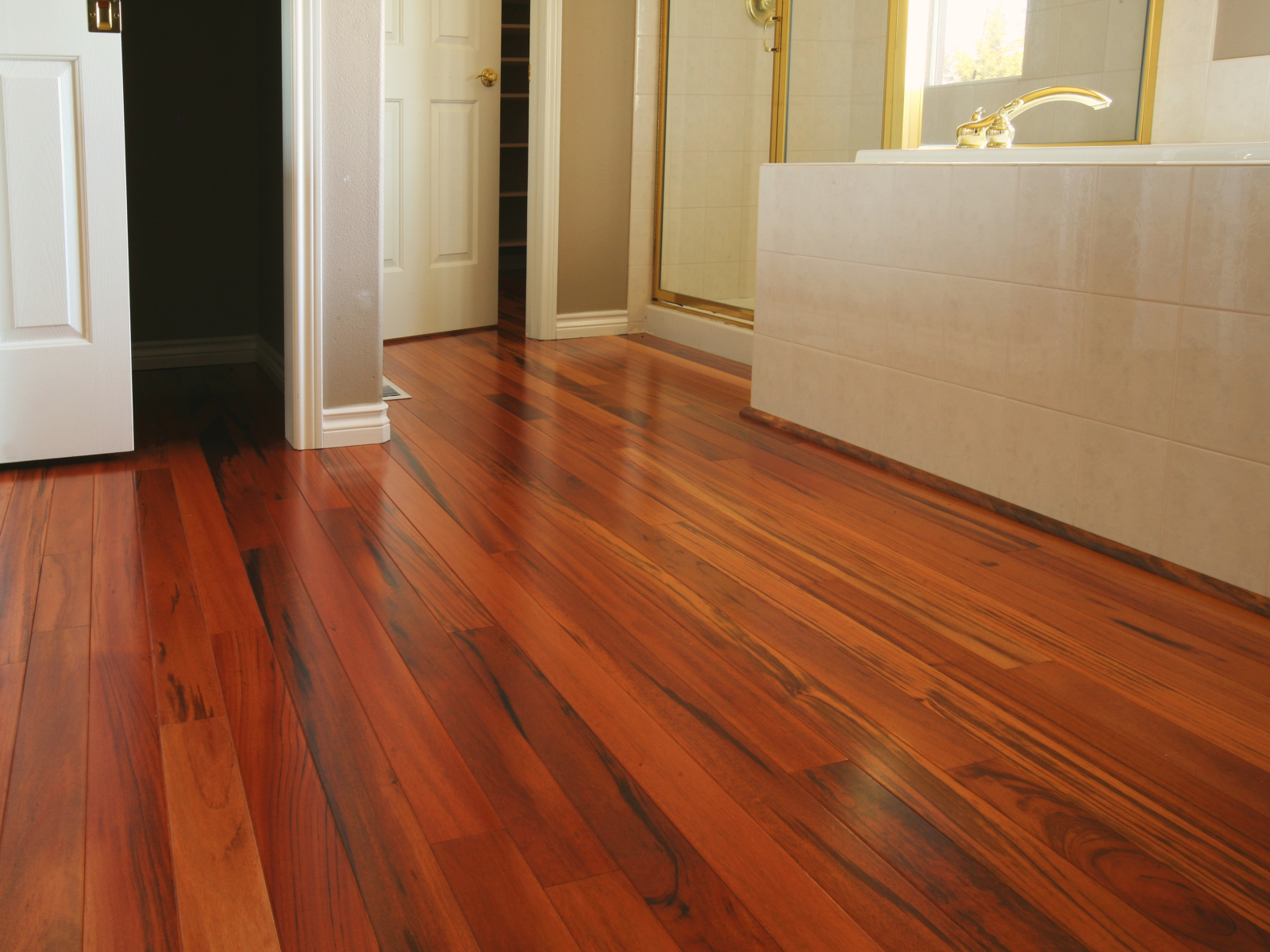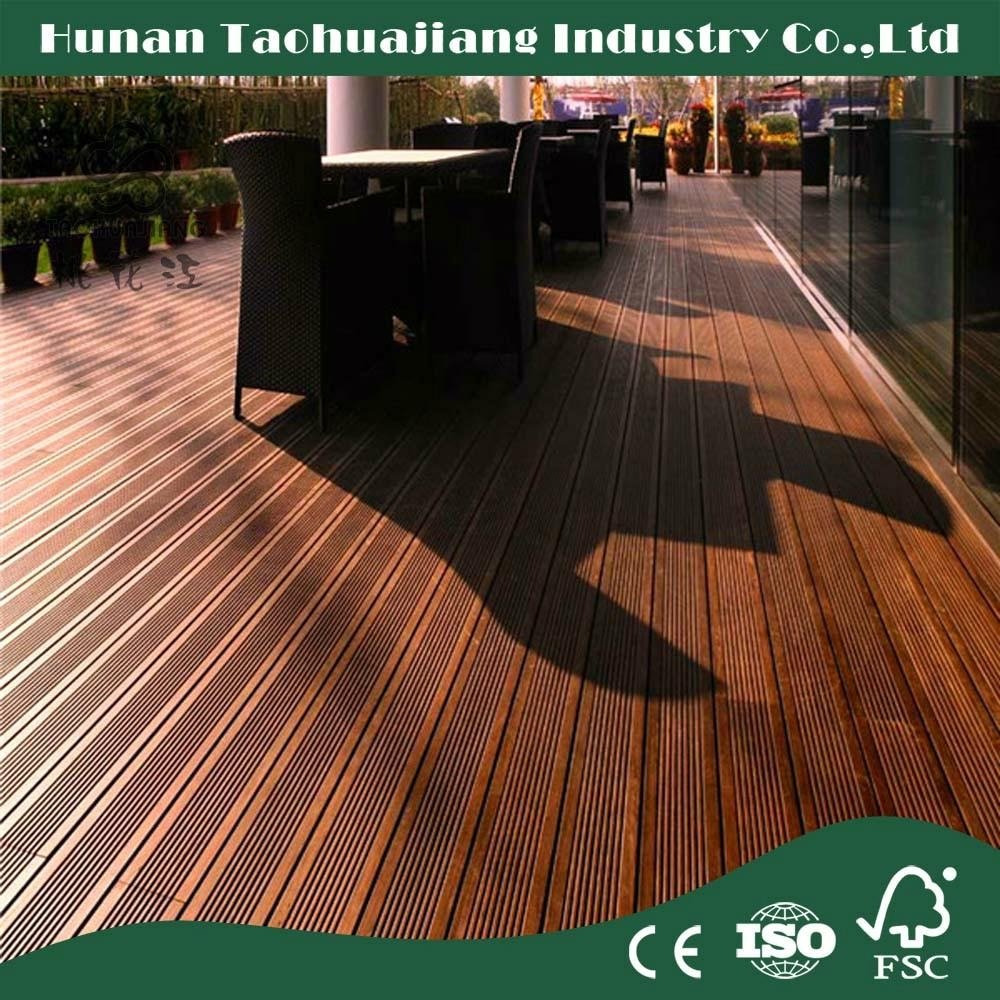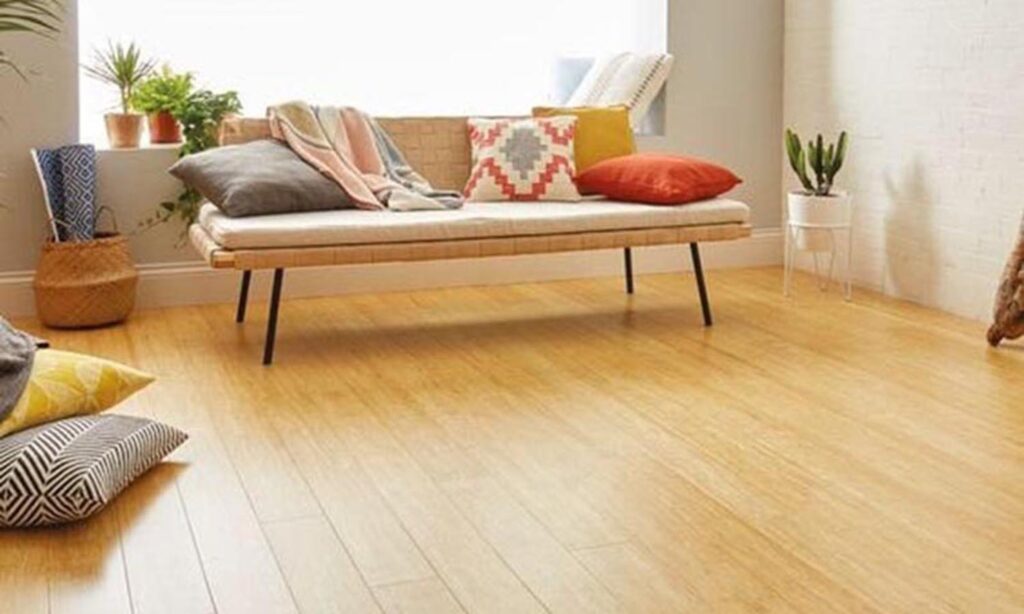Signs Your Bamboo Floor Needs Refinishing
Bamboo flooring is a durable and eco-friendly option that brings a natural beauty to your home. However, like all flooring materials, bamboo can show signs of wear and tear over time. Refinishing bamboo floors can revive their appearance and prolong their lifespan. But how do you know when it’s time to refinish your bamboo flooring? Here are several key signs that your floor may need a refresh.
- Fading or Discoloration: Over time, bamboo floors can fade due to exposure to sunlight, heavy foot traffic, and general wear. If you notice that your once vibrant bamboo floor has become dull or discolored, it’s a clear sign that refinishing is in order. The UV rays from sunlight, especially in rooms with large windows, can cause uneven discoloration across the floor. A refinishing process can help restore the original color and vibrancy, making the floor look as good as new.
- Visible Scratches and Scuff Marks: If your bamboo floor has noticeable scratches or scuff marks, it’s a sign that the protective finish is wearing down. This is especially common in high-traffic areas like hallways, living rooms, or entryways. While minor scratches can sometimes be buffed out, deeper gouges or widespread scratching may require a full refinishing job. Refinishing will smooth out the surface and provide a fresh protective layer to prevent further damage.
- Water Damage: Bamboo is relatively moisture-resistant compared to other types of hardwood, but it’s not immune to water damage. If you see signs of warping, swelling, or dark water stains, it’s a red flag. Water damage can not only ruin the look of your floor but also compromise its structural integrity. Refinishing can often salvage floors with light water damage, but more extensive damage may require replacing sections of the flooring.
- Loss of Shine: Over time, the protective coating on bamboo floors can wear off, leading to a dull, lackluster appearance. If your floor has lost its shine and no longer has the glossy finish it once did, it’s time to consider refinishing. A fresh coat of finish will bring back that luster and protect the floor from future wear and tear. Regular cleaning may not be enough to revive the lost shine, making refinishing the best option.
- Rough Texture or Surface Damage: If your bamboo floor feels rough to the touch or has splinters and raised areas, it’s a strong indication that refinishing is needed. This happens when the finish wears off completely, exposing the raw bamboo. At this stage, refinishing is crucial to prevent further damage and make the floor comfortable and safe to walk on again. A well-executed refinishing job will smooth the surface and reseal the bamboo for durability.
- Stubborn Stains: Bamboo flooring, especially in kitchens or dining areas, can accumulate stains from spills and dropped food. If these stains can’t be removed with regular cleaning or spot treatments, refinishing might be the solution. Sanding down the surface and applying a fresh coat of finish can remove even the most stubborn stains, leaving your floor looking pristine again.

Preparing Your Bamboo Floor for Refinishing
Before refinishing your bamboo floor, proper preparation is essential for a smooth and successful outcome. Taking the time to prepare the space and floor will ensure that the refinishing process goes smoothly and that your bamboo floor is left in perfect condition. Here’s a step-by-step guide on how to get your bamboo floor ready for refinishing.
Clear the Room of Furniture and Décor
The first step in preparing your bamboo floor for refinishing is to completely clear the room of all furniture, rugs, and décor. This will give you full access to the floor and make the refinishing process easier. Ensure that any heavy furniture is lifted rather than dragged to avoid scratching the bamboo further. Also, remove any baseboards or molding around the edges of the room to protect them during the sanding and refinishing process.
Thoroughly Clean the Floor
Once the room is cleared, it’s time to clean the floor. Sweep up any loose dirt, dust, or debris, then use a damp mop to clean the surface. It’s important to make sure the floor is as clean as possible before starting the refinishing process because any leftover dirt can get trapped in the finish and ruin the look of the floor. Be sure to use a cleaner that is safe for bamboo floors to avoid any damage.
Repair Any Damaged Areas
Inspect the floor for any damaged areas, such as deep scratches, gouges, or cracks. These will need to be repaired before refinishing. Small scratches can often be filled with a wood filler, while larger damage may require replacing individual planks. Addressing these issues beforehand will help ensure a smooth surface during the sanding and finishing process, preventing uneven spots or dips.
Sand the Floor
Sanding is one of the most important steps in preparing bamboo flooring for refinishing. You’ll need to rent a floor sander or hire a professional to handle this process. Sanding removes the old finish and smooths out the surface, creating a fresh, clean layer to work with. Be sure to sand evenly, and avoid over-sanding any areas, as bamboo is softer than traditional hardwood and can be damaged with excessive sanding.
Vacuum and Clean Again
After sanding, there will be a significant amount of dust and debris. Vacuum the floor thoroughly, making sure to get into the corners and along the edges. Then, use a tack cloth to pick up any remaining dust. This step is crucial because any leftover dust can interfere with the adhesion of the new finish, leading to a rough or uneven surface once the refinishing is complete.
Ensure Proper Ventilation
Before applying the new finish, ensure the room is properly ventilated. Open windows and use fans to create airflow, as this will help the finish dry more quickly and reduce the buildup of fumes from the refinishing products. Ventilation is especially important if you’re using solvent-based finishes, as they can emit strong odors and potentially harmful fumes.
Step-by-Step Guide to Refinishing Bamboo Floors
Refinishing bamboo floors is a multi-step process that requires attention to detail and patience. Whether you’re doing it yourself or hiring a professional, knowing the steps involved can help you ensure the job is done right. Below is a comprehensive guide to refinishing your bamboo floors, step by step.
Assess the Condition of the Floor
Before diving into refinishing, you need to assess the current state of your bamboo floor. Look for signs of damage like scratches, discoloration, or water damage. This will help you determine how much sanding is needed and whether any boards need to be replaced. For floors with deep gouges or extensive damage, you may need to consider replacing certain sections before proceeding with the refinishing process.
Sand the Floor
Sanding is a critical step in refinishing bamboo floors. The sanding process removes the old finish and smooths out any imperfections on the surface. Use a drum sander for large areas and an edge sander for the corners and edges of the room. Start with a coarse-grit sandpaper to remove the old finish, then progress to finer grits to smooth out the surface. Be sure to sand evenly across the floor to avoid dips or uneven areas.
Clean Up Dust and Debris
Once the floor is fully sanded, it’s essential to clean up all the dust and debris. Use a vacuum cleaner to remove loose particles from the floor, then wipe down the surface with a tack cloth to pick up any remaining dust. This step is crucial because any leftover debris can interfere with the adhesion of the new finish, leading to an uneven or bumpy surface.
Apply the New Finish
Now it’s time to apply the new finish. You can choose from several types of finishes, including water-based polyurethane, oil-based polyurethane, or even natural oils. Each has its pros and cons, so make sure to pick the one that best suits your needs. Apply the finish in thin, even coats using a brush or roller, following the manufacturer’s instructions. Be sure to work in the direction of the bamboo grain for the best results.
Allow Ample Drying Time
After applying the first coat of finish, allow it to dry thoroughly before adding additional coats. Drying times vary depending on the type of finish, the humidity level, and the ventilation in the room. Water-based finishes typically dry faster, while oil-based finishes may take longer. Plan for at least two to three coats of finish, allowing ample drying time between each layer.
Buff the Floor for a Smooth Finish
Once the final coat of finish has dried, buff the floor to achieve a smooth, polished look. Use a floor buffer with a fine abrasive pad to remove any minor imperfections and create an even sheen. This final step will give your bamboo floor a professional, high-quality appearance that will last for years to come.
Choosing the Right Finish for Your Bamboo Flooring
Choosing the right finish for your bamboo flooring is one of the most critical decisions in the refinishing process. The finish you select not only impacts the appearance of your floor but also its durability and resistance to wear and tear. Here’s a look at the most common types of finishes available for bamboo flooring and how to choose the one that’s best for your needs.
Water-Based Polyurethane
Water-based polyurethane is a popular choice for bamboo flooring because of its low odor, fast drying time, and clear finish. This type of finish is ideal for homeowners looking for a natural, less glossy appearance. It also has a lower environmental impact compared to oil-based finishes, making it a good choice for those who prioritize eco-friendliness. The downside of water-based polyurethane is that it may require more coats to achieve the desired level of protection.
Oil-Based Polyurethane
Oil-based polyurethane offers a durable, long-lasting finish that can withstand heavy foot traffic and wear. It provides a rich, glossy finish that enhances the natural color and grain of the bamboo. However, oil-based finishes tend to have a stronger odor and longer drying times compared to water-based options. If you’re looking for a more traditional, high-gloss finish and don’t mind the longer wait time, oil-based polyurethane might be the right choice for you.
Natural Oils
Natural oils, such as tung oil or linseed oil, are an eco-friendly option for finishing bamboo floors. These oils penetrate the bamboo, providing a matte or satin finish that enhances the natural beauty of the wood. While natural oils don’t offer the same level of protection as polyurethane, they are easier to maintain and can be reapplied as needed without sanding. This makes them a good choice for homeowners who prefer a more natural look and feel for their floors.
Wax Finishes
Wax finishes are another option for bamboo floors, though they are less commonly used today. Wax provides a soft, low-sheen finish that can be buffed to a shine. However, it doesn’t offer the same level of durability or moisture resistance as polyurethane or natural oils. Wax finishes require regular maintenance and reapplication, making them less practical for high-traffic areas or homes with pets and children.
Consider the Environment and Usage
When choosing a finish, it’s essential to consider the environment and how the floor will be used. For high-traffic areas or homes with pets and children, durability should be a top priority. In these cases, oil-based polyurethane or a high-quality water-based finish is often the best choice. For low-traffic areas or homeowners seeking an eco-friendly option, natural oils or water-based finishes may be more suitable.
Test the Finish Before Applying
Before committing to a finish, it’s a good idea to test a small area of the floor to see how it looks and reacts with the bamboo. This will give you a better idea of the final appearance and help you avoid any surprises once the entire floor is finished. Testing also allows you to ensure that the finish you’ve chosen complements the color and texture of your bamboo flooring.
Common Mistakes to Avoid During Refinishing
Refinishing bamboo floors can be a rewarding process, but it’s not without its challenges. There are several common mistakes that homeowners make during the refinishing process that can result in a less-than-perfect finish. Avoiding these mistakes can save you time, money, and frustration. Here’s a list of common refinishing errors and how to avoid them.
Skipping Proper Surface Preparation
One of the most common mistakes when refinishing bamboo floors is failing to prepare the surface properly. Skipping the cleaning or sanding steps can lead to a rough, uneven finish. Even the smallest particles of dust or debris can get trapped in the finish, creating an unsightly texture. Always take the time to thoroughly clean, sand, and vacuum the floor before applying any finish.
Over-Sanding the Bamboo
Bamboo is softer than traditional hardwoods, which means it can be damaged by excessive sanding. Over-sanding can wear down the bamboo and create uneven spots or dips in the floor. Always sand with care, using progressively finer grits of sandpaper to smooth the surface without removing too much material. If you’re unsure of your sanding technique, it may be best to hire a professional.
Applying Too Much Finish
Another common mistake is applying too much finish in one coat. This can lead to drips, bubbles, and an uneven surface. Instead, apply thin, even coats of finish and allow each coat to dry completely before adding the next. It’s better to apply several thin coats than to try and rush the process with one thick coat, as this will result in a smoother, more durable finish.
Not Allowing Enough Drying Time
Patience is key when refinishing bamboo floors. Rushing through the drying process is a mistake that can lead to smudges, streaks, or uneven spots in the finish. Always follow the manufacturer’s recommended drying times, and make sure the room is well-ventilated to allow for proper curing. If you’re using an oil-based finish, expect longer drying times than with water-based products.
Using the Wrong Type of Finish
Choosing the wrong finish can result in a floor that doesn’t look or perform as you expected. For example, using a high-gloss finish in a high-traffic area can lead to visible scratches and scuffs. Make sure to choose a finish that matches your lifestyle and the environment where the floor is located. If you’re unsure which finish is best, consult a flooring expert for advice.
Neglecting Post-Refinishing Care
Once the refinishing process is complete, proper care is essential to maintain the look and durability of your bamboo floor. Many homeowners neglect this step, leading to premature wear and tear. Follow the care instructions provided by the finish manufacturer, and avoid dragging furniture or wearing shoes that could scratch the surface. Regular cleaning and maintenance will help extend the life of your newly refinished floor.
Caring for Your Bamboo Floor After Refinishing
Once your bamboo floor has been refinished, it’s important to take proper care of it to ensure its longevity and maintain its beautiful appearance. Post-refinishing care is crucial for protecting the finish and preventing damage. Here are several tips on how to care for your bamboo floor after it has been refinished.
Allow the Finish to Cure Completely
After refinishing, the finish needs time to fully cure before the floor can be exposed to heavy use. While the surface may feel dry after a day or two, it can take up to a week (or longer for oil-based finishes) for the finish to harden completely. Avoid moving furniture back into the room or walking on the floor with shoes during this time. Give the floor the time it needs to cure properly to ensure a long-lasting finish.
Use Floor Protectors on Furniture
To avoid scratching the newly refinished surface, place felt pads or floor protectors on the bottoms of all furniture. This will prevent chairs, tables, and other heavy objects from causing damage when moved. Regularly check the condition of these protectors, as they can wear down over time, and replace them as needed to maintain optimal protection.
Sweep and Clean Regularly
Dust, dirt, and debris can act like sandpaper on your bamboo floor, gradually wearing down the finish. To prevent this, make sweeping and cleaning a regular part of your routine. Use a soft-bristle broom or a microfiber dust mop to keep the floor free of particles. For deeper cleaning, use a bamboo-friendly floor cleaner and a damp mop, being careful not to use too much water, as excess moisture can damage the floor.
Avoid Harsh Cleaners
It’s important to use the right cleaning products on your refinished bamboo floor. Harsh chemical cleaners or abrasive tools can damage the finish and dull its shine. Opt for a cleaner specifically designed for bamboo or hardwood floors, and avoid using vinegar, bleach, or ammonia-based products, as these can strip the finish and cause discoloration.
Control Humidity Levels
Bamboo is sensitive to changes in humidity, which can cause the material to expand or contract. To protect your refinished floor, try to maintain consistent humidity levels in your home. Use a humidifier in the winter when the air is dry, and a dehumidifier in the summer if necessary. Keeping the humidity between 40-60% will help prevent the bamboo from warping or cracking over time.
Address Spills and Accidents Promptly
Accidents happen, but how you handle them can make a big difference in preserving the finish on your bamboo floor. Wipe up spills immediately to prevent moisture from seeping into the bamboo and causing damage. For tougher stains, use a soft cloth and a bamboo-friendly cleaner. Avoid using excessive water, as this can damage the finish and lead to warping or discoloration.
Home Flooring Ideas: 5 Tips & Tricks for Installing Bamboo Flooring – Home Improvements AU
Bamboo Flooring Melbourne
Shop Cali Bamboo Prefinished Antique Java Bamboo Hardwood Flooring (21.5-sq ft) at Lowes.com
BAMBOO FLOORING – Modern Bamboo
Related Posts:








